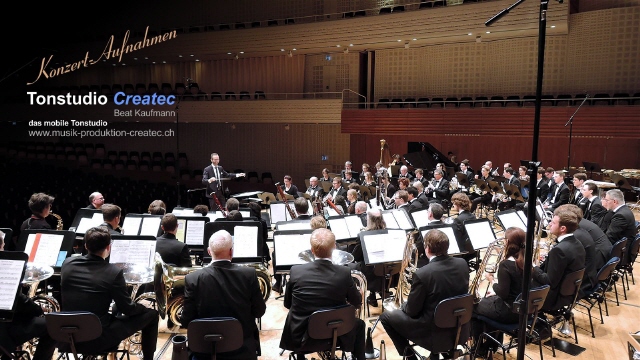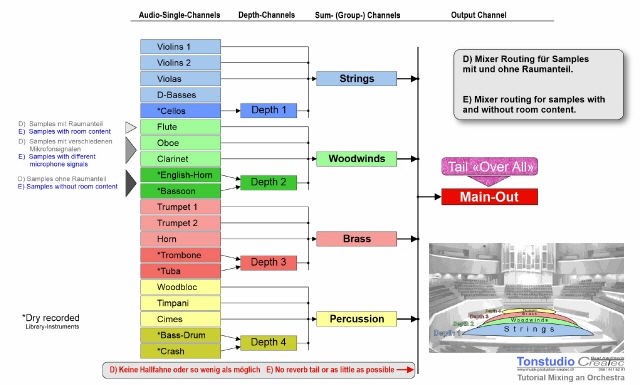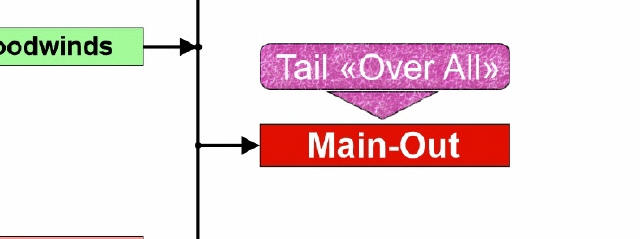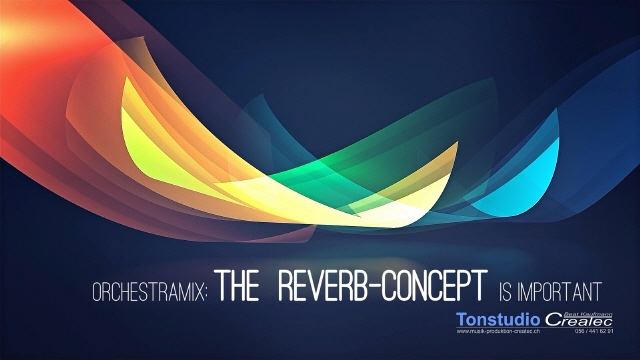Reverb-Concept 2023
So kann das Hallkonzept 23 klingen... / That's the sound of the Reverb-Concept 23
realtiv hell abgemischte Version mit wenig Hallfahne... / bright mixed version without a lot of reverb tail...
- VIDEO
- / / / Deutsch
- Das "Reverb Concept 2023"
- Üben
- / / / English
- The "Reverb Concept 2023"
- Practice

Mit jedem Instrument, das einer größeren Orchestermischung hinzugefügt wird, neigt die betreffende Mischung dazu, undurchsichtiger und sogar zu einem undefinierten "Audiosumpf" zu werden. Aber es gibt Lösungen, die ein Orchester auch in einer größeren Produktion ganz natürlich klingen lassen können. Einer der wichtigsten Punkte ist die "Tiefenstaffelung" der Instrumente. Das bedeutet, die Instrumente in verschiedenen virtuellen Bühnentiefen spielen zu lassen. Dort, wo sie auch in der Realität spielen und gehört werden würden.
Sie haben vermutlich noch nie die Blechbläser-Sektion in einem Konzertsaal vor den Streichern spielen sehen. Also sollten Sie auch in Ihren Mischungen alles tun, um die Blechbläser deutlich hinter den Streichern klingen zu lassen. Wenn Sie dabei sogar ein bisschen übertreiben, schadet das überhaupt nicht - im Gegenteil.
Wie das geht, zeigt das Video in diesem Artikel. Da in diesem Zusammenhang der Effekt "Reverb" stark ins Spiel kommt, habe ich dem Kapitel den Namen "Reverb Concept" gegeben. Es könnte aber auch Namen wie "Mixing Concept", "Stage Concept" usw. tragen.
zuerst ein reelles Beispiel...
Wie Sie wissen, produziere ich Ton- & Video-Aufnahmen und damit Ton-Mischungen für Kunden, die mich in der Regel beauftragen, eines ihrer Konzerte aufzunehmen. Über alle die Jahre haben sich 2 Dinge herauskristallisiert:

A) Die Kunden wollen möglichst viele Details hören.
B) Die Kunden wollen ihre Konzertsituation erkennen.
OK, stellen wir zwei Mikrofone auf in der Konzertsaalmitte, dann ist B) sicher erfüllt. Mehr als einmal stellte ich dort Mikrofone auf, um Kunden den "Zuhörer-Sound" zu zeigen. Nur diesen wollten Sie letztlich nie. Weil A) damit nicht erfüllt war. Zuhörer sind sich eben von den vielen Musik-Konserven auch gewöhnt, wie etwas zu klingen hat. Was will ich damit sagen?
Als Mischer haben wir meist die Aufgabe, eine virtuelle Konzertsituation zu kreieren, welche Details zeigen kann und trotzdem irgendwie die Konzertsituation aufzeigt. Die tatsächliche Wirklichkeit will eigentlich niemand hören - weil sie meist total unspektakulär und verwaschen klingt.
Den Punkt B) erreichen wir also nicht, indem wir das Orchester möglichst weit weg erklingen lassen, also die Zuhörerposition im Saal (ganzer Mix mit viel Hall), sondern indem wir vor allem die Bühne gut nachbilden, so dass z.B. die Perkussion eher entfernt erklingt und in unserem Fall die Holzbläser möglichst nahe. Gleichzeitig erfüllt man so Punkt A) in grossem Ausmass. Das ist einer der Ansätze, welchen ich bei Live-Aufnahmen verfolge.
Hören Sie nun das kurze Blasmusik-Beispiel aus dem KKL-Luzern...
Achten Sie bitte darauf, in welcher Raumtiefe die verschiedenen Sektionen spielen und welche unglaubliche Transparenz dadurch der Mix hat.
Wie erreicht man das mit Samples?
Damit Sie auch mit Samples ein transparentes Mix-Ergebnis erreichen, ist eine gute Tiefenstaffelung eine der wichtigsten Voraussetzungen. Mein nachfolgend vorgestelltes "Reverbkonzept 2023" zeigt eine Möglichkeit auf, wie man die Sache mit der Raumtiefe lösen kann. Arbeiten Sie mit verschiedenen Libraries haben Sie sicher oft das Problem, dass Instrumente schon positioniert sind (auch in der Raumtiefe) und andere Libraries offerieren nur trockenen Instrumenten-Sound. Diese Instrumente sind dann auch noch in der Tiefe zu positionieren. Mein Reverbkonzept integriert beide Instrumententypen, DRY und WET.

Das Video zeigt:
Beim vorgestellten Hallkonzept geht es zunächst darum, die Instrumente in der "richtigen" Tiefe des Konzertraumes spielen zu lassen, egal welche Samples man verwendet.
Verwendet man trockene Samples, dann muss man etwas tun, damit die Instrumente akustisch nach hinten rutschen, falls das nötig sein sollte. Das Schema zeigt das mit einer zusätzlichen Schlaufe im Mixer (Depth 1-4), die die "trockenen Instrumente" in die selbe Raumtiefe bringt, wie jene Instrumente, welche bereits mit entsprechender Raumtiefe gesampelt sind.
Bei Samples, die die Raumposition bereits im Klang enthalten, muss man nichts tun, man kann sie direkt verwenden.
Ganz wichtig ist, dass Sie bei diesem Hallkonzept und bei der Positionierung der Instrumente diese zunächst nur mit Raumtiefe, nicht aber auch mit einer Hallfahne versehen.
So könnte das dann für die Pauke klingen:
verschiedene Raumtiefen "DRY Timpani" OHNE TAIL

Dadurch wird erreicht, dass die Instrumente im richtigen Abstand spielen. Durch das Weglassen der Hallfahne bei den einzelnen Instrumenten wird der Mix nicht unnötig "dick". So klingt er auch bei vielen Instrumenten transparent und es entsteht kein akustischer Sumpf. Natürlich bekommt die Mischung eine Hallfahne, aber eben nur einmal für die gesamte Mischung im Ausgangskanal.
Das Video und das obige Mischungsbeispiel zeigen dies sehr schön.
So klingt übrigens die Timpani mit dem "Tail over all"... da braucht sie sicher nicht selber auch noch verhallt zu werden, nicht?
verschiedene Raumtiefen "DRY Timpani" MIT TAIL

Damit du selber den Mix ausprobieren kannst, steht er hier zum Download bereit. Die Positionen sind bereits zur Hauptsache in den Audiofiles enthalten. Du kannst mit den Files auch hören, wie die Instrumente klingen sollten, wenn du das Konzept für deine Mixe übernehemen willst.
- Wie man Instrumente in die Tiefe schieben kann, erfährst du z.B. hier...
- Wie man Instrumente mit verschiedenen Mikrofonen in der Tiefe positioniert, erfährst du hier...
- Wie man Synchronized Instrumente (VSL)positioniert, erfährst du hier...
- Wie man einen Tail bekommt, ohne gleichzeitige Tiefenverschiebung, erfährst du in diesem Video...
Im Tutorial "Mixing an Orchestra" erkläre ich ziemlich ausführlich meinen Mix*. Dies als Ergänzung zu den vielen theoretischen Erklärungen.
Zudem können Sie mit diesen Hinweisen sehen, wo Ihre Effekte von meinen Abweichen. Manchmal ist ja auch hilfreich zu sehen, wie andere ein Problem lösen.
*ab Tutorial-Version 1.77, April 23

With each instrument added to a larger orchestral mix, the mix in question tends to become more opaque and even an undefined "audio swamp". But there are solutions that can make an orchestra sound natural even in a larger production. One of the most important points is the "depth staggering" of the instruments. This means having the instruments play at different virtual stage depths. Where they would play and be heard in reality.
You have probably never seen the brass section play in front of the strings in a concert hall. So you should also do everything in your mixes to make the brass sound clearly behind the strings. If you even exaggerate a little, it won't do any harm - on the contrary. The video in this article shows how to do this. As the "Reverb" effect comes into play a lot in this context, I have given the chapter the name "Reverb Concept". However, it could also be called "Mixing Concept", "Stage Concept" etc.
First a real example...
As you know, I produce sound & video recordings and therefore sound mixes for clients who usually hire me to record one of their concerts. Over the years, 2 things have crystallized:

A) Customers want to hear as much detail as possible.
B) Customers want to recognize their concert situation.
OK, let's put two microphones in the middle of the concert hall, then B) is certainly fulfilled. I have set up microphones there more than once to show customers the "listener sound". But in the end they never wanted it. Because A) was not fulfilled. Listeners are used to how something should sound from all the music they listen to. What do I mean by that?
As mixers, we usually have the task of creating a virtual concert situation that can show details and still somehow reveal the concert situation. Nobody really wants to hear the actual reality - because it usually sounds totally unspectacular and blurred.
So point B) is therefore not achieved by having the orchestra sound as far away as possible, i.e. the audience position in the hall (whole mix with lots of reverb), but by recreating the stage well so that, for example, the percussion sounds rather distant and in our case the woodwinds sound as close as possible. At the same time, this fulfils point A) to a large amount. That's one of the approaches I take with live recordings.
Now listen to the short brass music example from the KKL-Lucerne (Switzerland)...
Please pay attention to the depth of the different sections and the incredible transparency of the mix.
How do you achieve this with samples?
In order to achieve a transparent mix result with samples, a good spatial depth is an important factor. My "Reverb concept 2023" presented below shows one way to solve the problem of spatial depth. If you work with different libraries, you will often have the problem that instruments are already positioned (also in the depth of the room) and other libraries only offer a dry instrument sound. These instruments must then also be positioned in the depth. My reverb concept integrates both instrument types, DRY and WET.

The video shows:
The reverb concept presented is about making the instruments play in the "right" depth of the concert room first, no matter what samples you use.
With dry samples, you have to do something to make the instruments slip acoustically to the back, if that should be necessary. The diagram shows this with an additional loop in the mixer (Depth 1-4), which brings the "dry instruments" to the same spatial depth as those instruments that are already sampled with the corresponding spatial depth.
With samples that already contain the room position in the sound, you don't have to do anything, you can use them directly.
What is really important, hat with this reverb concept and when positioning the instruments, you initially only provide them with room depth, but not also with a reverb tail.
This is how it could sound for the timpani:
Different Depths "Dry Timpani" WITHOUT TAIL

This ensures that the instruments play at the correct distance. By omitting the reverb tail for the individual instruments, the mix does not become unnecessarily "thick". So it sounds transparent even with many instruments and there is no acoustic swamp. Of course the mix gets a reverb tail, but only once for the entire mix in the output channel.
The video and the mixing example above show this very nicely.
By the way, this is how the timpani sounds with the "Tail over all"... surely it doesn't need to be reverberated itself, does it?
Different Depths "Dry Timpani" WITH TAIL

So that you can try out the mix yourself, it is available for download here. The positions are already included in the audio files. You can also use the files to hear how the instruments should sound if you want to adopt the concept for your mixes.
- How to push instruments in depth, you can learn e.g. here...
- How to position instruments with different microphones in the depth, you will learn here...
- How to position Synchronized Instruments (VSL), you will learn here...
- How to get a tail without simultaneous depth shifting, youwill learn in this video...
In the tutorial "Mixing an Orchestra" I explain my mix* quite detailed. This as a supplement to the many theoretical explanations.
In addition, you can use these notes to see where your effects differ from mine. Sometimes it is helpful to see how others solve a problem.
*from tutorial version 1.77, April 23

